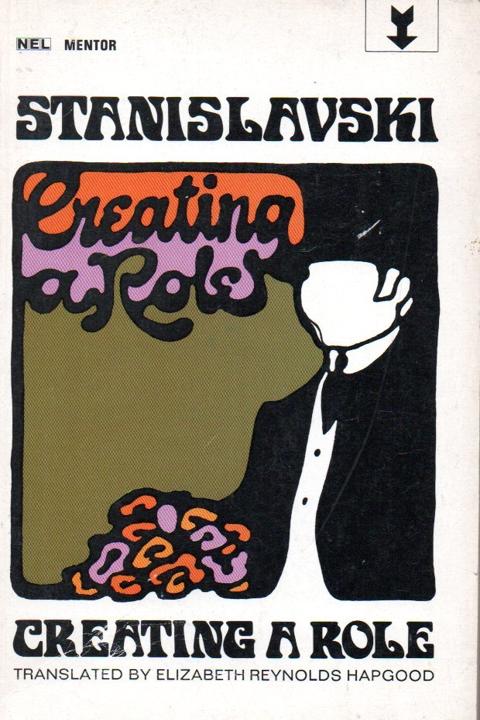Last updated on 2025/05/01
Creating A Role Summary
Konstantin Stanislavsky
Mastering Character Through Emotional Truth and Imagination.
Last updated on 2025/05/01
Creating A Role Summary
Konstantin Stanislavsky
Mastering Character Through Emotional Truth and Imagination.
Description

How many pages in Creating A Role?
100 pages
What is the release date for Creating A Role?
In "Creating A Role," Konstantin Stanislavsky unveils the transformative journey of an actor, delving deep into the intricate process of character development and embodiment. Through his innovative techniques, Stanislavsky emphasizes the importance of understanding a character’s psychological motivations and emotional truths, urging performers to transcend mere imitation and strive for authenticity on stage. This seminal work reveals how personal experience and imagination can be harnessed to breathe life into roles, ultimately guiding the reader to appreciate not just the craft of acting, but the profound connection between art and human experience. Engaging and insightful, Stanislavsky’s teachings resonate beyond the theater, offering valuable lessons in creativity, empathy, and self-discovery that are relevant to anyone seeking to understand the complexities of human nature.
Author Konstantin Stanislavsky
Konstantin Stanislavsky was a pivotal figure in the world of theatre, renowned for his revolutionary contributions to acting methodologies that transformed the art form in the early 20th century. Born in 1863 in Moscow, Russia, he co-founded the Moscow Art Theatre and was instrumental in the development of naturalistic performance, which emphasized the psychological realities of character portrayal over traditional theatrical conventions. His innovative approaches, encapsulated in his famed "system", encouraged actors to draw from their own experiences and emotions to create more authentic and believable performances. Stanislavsky's influence extends far beyond the confines of Russia; his teachings have resonated with actors globally, shaping acting practices and education, and solidifying his legacy as a cornerstone of modern theatre.
Creating A Role Summary |Free PDF Download
Creating A Role
Chapter1 | Griboyedov’s Woe from Wit
In the exploration of role preparation as articulated by Konstantin Stanislavski in "Creating A Role", the initial chapter delves into the intricate process of embodying a character in the context of Griboyedov's "Woe from Wit". This foundational chapter outlines a structured approach to role preparation, emphasizing three pivotal periods: the initial study of the role, the establishment of the character's life, and the transition to physical embodiment. 1. First Impressions: The journey begins with the actor’s first encounter with the script, reminiscent of an initial meeting that leaves a lasting impression. These fresh encounters serve as seeds for artistic enthusiasm and creativity. The actor must engage with the text in a receptive state, avoiding preconceived notions and biases that could distort their connection to the material. An actor's first impressions significantly influence their emotional relationship with the role, and the authenticity of these impressions is crucial to the creative process. 2. Analysis: As the actor delves into the script, analysis emerges as a vital tool for understanding both the character and the entirety of the play. This analytical stage transcends mere intellectual engagement; it becomes an emotional journey. Effective analysis empowers the actor to connect with the subconscious layers of their character, accessing deeper emotional truths that drive the portrayal. Stanislavski emphasizes that feeling, rather than intellect, drives artistic creation, and the analysis should evoke genuine emotional responses aligned with the character's circumstances. 3. Establishing External Circumstances: Gradually, the actor transitions from examining the text to unraveling the external circumstances underpinning the character's actions. This phase involves a meticulous exploration of facts and conditions presented by the playwright—social context, psychological constructs, and interpersonal relationships must all be understood. Stanislavski encourages actors to cultivate an intimate knowledge of their character's surroundings and interactions, enabling them to imbue their portrayal with authenticity and depth. 4. Creating Inner Circumstances: Beyond physical settings and actions, the actor must also generate an internal landscape for their character. This involves transforming the intellectual understanding of circumstances into a vivid emotional experience. By deeply immersing themselves in the character’s emotional reality, actors can seamlessly inhabit the role, developing a genuine sense of belonging within the story. 5. Role of Imagination: Imagination plays a crucial role in this transformative journey. Stanislavski advocates for the use of active imagination to forge connections between the actor and the character’s experiences. By visualizing and emotionally investing in the character's life situations, actors create a dynamic interaction with the role, leading to a richer portrayal. 6. Continuous Reflection and Reevaluation: Importantly, Stanislavski emphasizes the ongoing nature of this process. Actors must continually reassess their understanding of both the character and the narrative as they perform. Role preparation is portrayed as an evolving practice, where the actor learns to adapt and refine their approach based on fresh insights and experiences gained during rehearsals and performances. Through these outlined principles, Stanislavski provides a framework for actors to engage deeply with their roles, ultimately creating a multi-faceted performance that resonates with both the audience and the actor themselves. The chapter serves as a prelude to the intricate methods of character building that will be further elaborated upon as the text progresses.
Chapter2 | The Period of Emotional Experience
In this chapter, "The Period of Emotional Experience," Konstantin Stanislavsky outlines the critical phase in the acting process that follows initial preparation. This phase is compared to consummation, marking a transition from mere understanding to the birth of a character. He emphasizes the importance of emotional experience in creating authenticity and sincerity within a role, likening this process to the planting and nurturing of a seed, where an actor internalizes the playwright's creation, allowing it to blossom through their unique emotional and spiritual life. 1. The creation of a role begins when an actor engages deeply with the character’s emotions. The preparatory phase lays the groundwork, presenting the circumstances and inherent conflicts. The second phase is where inner impulses and actions arise, spurring the actor towards true emotional engagement. Understanding these impulses is essential; they represent the desires that drive the character’s actions, forming an organic connection to the narrative. 2. Stanislavsky illustrates these inner impulses through personal anecdotes from his own experiences, showcasing how emotional desires and objectives lead to inner actions, which subsequently manifest as external actions on stage. The distinction he makes between impulses and actions is crucial—impulses are the driving force, while actions are the expression of these impulses. 3. He argues that dramatic action is not merely physical movement but rather an expression of inner life and spiritual activity. Scenic action must stem from genuine emotional truth, integrating both physical movement and psychological intention. A performance devoid of this connection becomes stale and clichéd, failing to resonate with the audience. 4. The significance of having clear, attractive objectives cannot be understated. An actor must find motivational aims that evoke emotional responses. The inner desires generated by these objectives become the actor's lifeblood on stage, driving their performance. Stanislavsky emphasizes that creative objectives—whether conscious or intuitive—should awaken genuine feelings and a sense of purpose in the actor’s portrayal. 5. An actor's journey is marked by the interplay of physical and psychological objectives, united by the actor’s internal emotional landscape, which gives depth to their performance. This "score" constitutes a structured yet flexible framework, enhancing the actor’s ability to embody their character’s emotions honestly. 6. A superobjective, or overarching goal of the performance, is revealed as the essential component that ties all smaller objectives together. It encapsulates the actor's drive throughout the piece, informing every moment they inhabit on stage. Each secondary objective relates to this superobjective, creating a dynamic, interconnected tapestry of emotional experience. 7. Stanislavsky also explores the idea of superconsciousness as a realm of emotion that transcends conscious thought. Creativity stems from accessing this unconscious depth, suggesting that genuine artistic inspiration requires preparation, patience, and a harmonious internal state that aligns the actor’s essence with the role they play. 8. The successful portrayal of complex human emotions, such as love or conflict, is rooted in the rich interplay of varied feelings. It demands that actors explore the nuances of passion through their performances, bending emotional dynamics with profound complexity. This multiplicity adds depth to their representation of human experience on stage. Ultimately, the chapter underscores the organic nature of acting, stressing that emotional experience—grounded in personal truth and artistic instinct—is vital for creating compelling, life-like characters. The blending of conscious and unconscious processes lays the groundwork for artistic expression, setting the stage for authentic and engaging performances that resonate deeply with audiences.
Key Point: Emotional Experience as Authentic Connection
Critical Interpretation: Imagine yourself stepping onto a stage, your heart racing as you prepare to embody a character. This chapter reminds you that the journey of authenticity begins with emotional experience, urging you to delve deeply into your own feelings and thoughts, much like nurturing a seed into a blooming flower. This perspective encourages you to approach your everyday life with the same fervor—by actively engaging with your own emotional truths and desires, you can create more meaningful connections and experiences. Just as an actor uncovers their character's intentions through emotional exploration, you too can discover your own motivations, enriching your life with purpose and sincerity in every interaction.
Chapter3 | The Period of Physical Embodiment
In Chapter Three of "Creating A Role," Konstantin Stanislavsky delves into the transformative journey an actor undergoes as they move from the conceptual phase of role preparation to the embodiment of their character on stage. This third period of creativity is likened to the birth and upbringing of a child, where the actor takes the desires and objectives cultivated in previous phases and manifests them through physical expression and emotional truth. To illustrate this process, Stanislavsky uses the example of preparing to play Alexander Chatski. He emphasizes that mere self-deception—attempting to become someone else—is futile. An actor must remain grounded in their own identity while adopting the essence of the character. Thus, when preparing for a rehearsal, instead of forcing imagined circumstances, the actor should draw on genuine experiences and emotions, relating their own feelings of coming home after a long journey to those of Chatski. 1. An actor begins by asserting their state of existence—acknowledging the reality of being themselves and simultaneously channeling the persona of Chatski. This involves reflecting on personal experiences that parallel the character’s journey, enabling the actor to grasp the emotional weight of returning home—an experience rich with nostalgia, warmth, and anticipation. 2. Next, the actor contemplates the emotional significance for Chatski when heading to see Famusov and Sophia. Rather than simply mimicking what Chatski might feel, the actor taps into their own memories of love and excitement to portray the character authentically. This personal resonance imbues the role with deeper emotional layers. 3. As rehearsals begin, however, the actor encounters a stark shift. What once felt coherent and prepared can dissolve into uncertainty, revealing a sense of helplessness. This turmoil is an intrinsic part of the creative process, reminiscent of "labor pains." Every actor, regardless of experience, faces these moments of doubt when transitioning from internal preparation to external expression. 4. Stanislavsky stresses that the emotional depth embedded in a script must be harnessed—not merely repeated. The true genius of a playwright like Griboyedov resides in every word, which must resonate with live emotions within the actor. Only then can the words transform from empty vessels into powerful conduits of expression during performances. 5. The actor's challenge is to find a physical embodiment for the emotional score of their character, ensuring that every gesture, movement, and vocal inflection aligns with their inner feelings. For this, an actor must cultivate a thorough understanding of both their own emotional responses and the character’s circumstances while striving for an authentic, graceful portrayal free from cliché gestures. 6. Throughout this journey, improvisation becomes a vital tool. Actors must engage with their surroundings, blending real-life stimuli with the fictional world of the play. Through improvised exercises, actors can express their feelings and desires, allowing their characters to emerge organically. 7. Ultimately, the embodiment encompasses not just emotions but also the external portrayal of the character's physical presence, requiring meticulous attention to details such as costume and makeup. The actor is encouraged to explore their imagination and arrive at a harmonious fusion of inner and outer characteristics. 8. The culmination of this process is an intense emotional connection that transcends the visible performance. Stanislavsky highlights that true artistic communication happens through invisible currents of emotion shared between actor and audience—an experience that goes beyond words or movement, creating a profound bond that captivates viewers. In conclusion, the crafting of a character involves both mental acuity and physical skill, where each nuance reflects a complex tapestry of emotional truth. Stanislavsky reminds aspiring actors that the mastery of their craft is a lifelong journey, one that demands sincerity, dedication, and continual exploration of both self and character. Through this rigorous process, an actor not only embodies a role but also experiences personal growth, discovering deeper layers of human emotion that resonate with audiences across time and culture.
Chapter4 | Shakespeare’s Othello
In Chapter Four of "Creating A Role," Konstantin Stanislavski explores the intricate process of preparing for the role of Othello, guiding a group of acting students through both theoretical and practical approaches to understanding a play. The chapter begins with Tortsov, the teacher, emphasizing the importance of selecting a complex, rich text for their studies, ultimately deciding on Shakespeare's *Othello*. He argues that despite its challenges, the play offers excellent opportunities for each student to engage meaningfully with their characters. 1. Importance of the Text: Tortsov highlights the necessity for actors to be deeply familiar with the entirety of a play rather than just their roles. He laments that many students have superficial knowledge of *Othello*, acknowledging how prejudices from previous encounters with the play—whether through truncated readings or external influences—affect their understanding. Tortsov insists that first impressions from the initial reading are critical and should be as pristine as possible to facilitate genuine artistic growth. 2. Understanding Prejudice: The chapter dives into the concept of prejudice, explaining that preconceived notions about a play can come from various sources—including critical analysis or incomplete readings. Tortsov stresses that these prejudices can distort an actor's understanding and portrayal of their role. The dialogue reveals how the students had formed opinions based on fragmented experiences with the text, reinforcing the need for a comprehensive and unbiased encounter with the play for effective preparation. 3. The Role of Intuition: Tortsov proposes that actors should rely on their intuition when approaching a character. He suggests that creativity often arises from personal emotional responses to the text, which can be stifled by excessive intellectual analysis or preconceptions. He encourages the students to trust their emotional instincts and recognize that genuine connections with their parts come from their innate understanding of the material. 4. Deepening Engagement: To strengthen their association with Othello, Tortsov lays out strategies for subsequent readings that focus on enhancing emotional connections. He advocates for creating an inviting atmosphere during readings, one that encourages shared enthusiasm and open exploration of the text. By rediscovering and deepening their understanding, the actors can uncover the emotional depth and thematic richness Shakespeare embedded in his work. 5. Clarifying Structure: Tortsov emphasizes the importance of recognizing a play's structure—its "skeleton"—to grasp the essential events and motivations that drive the narrative. Through guided discussion, he prompts the students to identify critical circumstances that must exist for the play to unfold, ensuring they have a solid foundation upon which to build their performances. In conclusion, Chapter Four serves as a foundational exploration of how actors must engage with a text on multiple levels—intellectually, intuitively, and emotionally—if they are to inhabit their roles authentically. Stanislavski's insights cultivate a holistic approach to acting, reinforcing that understanding character dynamics, recognizing the impact of preconceived biases, and maintaining enthusiasm are pivotal to the creative process.
Key Point: Understanding Prejudice
Critical Interpretation: Think about how often you approach new experiences or ideas with preconceived notions, perhaps influenced by the opinions of others or previous encounters. Just as Tortsov enlightens his students on the necessity for a fresh perspective when engaging with Shakespeare’s *Othello*, you too can benefit from setting aside your biases and embracing a clean slate in your life. When you encounter someone new or a challenging situation, remind yourself to look beyond your initial impressions and let go of previous judgments. Opening your mind can unlock genuine understanding, foster deeper connections, and inspire personal growth in ways you never anticipated. By doing so, you allow the richness of each experience to resonate, encouraging transformative insights that enhance your journey.
Chapter5 | Creating the Physical Life of a Role
In Chapter Five of "Creating A Role" by Konstantin Stanislavsky, the focus is on establishing the physical life of a character through practical exercises, emphasizing the interplay between internal emotions and external actions. Tortsov, the instructor, presents a method that builds on the relationship between a character's inner qualities and their physical actions, suggesting that physical movements can facilitate a deeper understanding and feeling of the role. Initially, Tortsov challenges his students' perceptions of acting by asking them to perform a scene from "Othello" without scripts or preparation. This exercise highlights their reliance on theatrical norms rather than genuine actions. Tortsov insists that each actor must learn to walk, stand, and situate themselves within the scene as their character would, shifting the focus from merely entertaining an audience to authentically engaging with the environment and objectives of the scene. As the students attempt to raise an alarm in the scene, Tortsov critiques their approaches, emphasizing that they are overly concerned with audience perception, resulting in forced actions rather than natural ones. He teaches them the importance of realistic objectives—examining windows for lights, making noise to awaken the household, and expressing genuine urgency. Success lies in acting with a genuine intention that connects with the audience on an emotional level, rather than resorting to theatrical clichés. To further enhance their performance, Tortsov directs Grisha and Vanya to embody the physicality of gondoliers, which allows them to focus positively on their actions and objectives. This exercise leads to a heightened sense of creative energy, encouraging them to explore their characters' motivations and emotional states. By guiding the actors to think beyond the text, Tortsov steers them toward an instinctive understanding of their roles that is rooted in physical truth. The exercises also delve into the psychological aspects of the character, discussing the sequence of emotional responses that Brabantio would experience upon receiving the alarming news. Tortsov details a series of logical steps to depict Brabantio's denial and eventual acceptance of the distressing reality, guiding the actors through the emotional landscape that influences their actions. The chapter concludes with Tortsov stressing the necessity of merging physical actions with inner emotional life, explaining that the body’s movements should naturally resonate with the spirit of the character. This dual approach of embodying both the physical and psychological aspects of a role is framed as essential to the development of a believable performance. Tortsov also warns against the pitfalls of acting that is driven by external expectations rather than genuine emotion, encouraging the students to cultivate their abilities to connect deeply with their characters. Overall, the key concepts of this chapter can be summarized in the following points: 1. Physical Approach: Engaging the physical life of a character establishes a strong foundation for authentic performance. 2. Natural Actions: Avoid theatrical clichés; strive for genuine physical objectives that connect with the environment. 3. Authentic Objectives: Each action should stem from real intentions, allowing emotions to emerge organically rather than mechanically. 4. Psychological Sequence: Understand characters' emotional responses and develop logical sequences to portray their psychological journeys. 5. Inner and Outer Merge: True acting requires the blending of physical and emotional life, where each supports and enhances the other for a (fulfilling performance). Through these teachings, Stanislavsky articulates the importance of finding a balance between internal and external expressions in developing a role. The chapter provides a clear roadmap for actors, emphasizing the necessity of sincere and purposeful engagement with their craft.
Key Point: Inner and Outer Merge
Critical Interpretation: Imagine stepping into your own life with the same commitment and authenticity that an actor brings to a role. By merging your internal feelings with your external actions, you can find deeper meaning in everyday experiences. Picture yourself addressing challenges not just with words but through genuine feelings and intentions, allowing your true self to shine through. This chapter encourages you to engage with the world around you fully—moving past societal expectations to pursue your genuine objectives. Just as actors inhabit their characters, you can embody your authentic self, leading to richer interactions and more fulfilling relationships.
Chapter6 | Analysis
Chapter Six of "Creating A Role" by Konstantin Stanislavsky delves deeply into the analysis necessary for an actor to fully embody their character in a play, particularly focusing on Shakespeare's works. In the beginning, Tortsov, the instructor, emphasizes the importance of allowing roles to unfold naturally within an actor, as this organic development creates authenticity. Unfortunately, this "magic" was absent in the actors’ performances, indicating that they needed a structured approach to stimulate their creative faculties. Thus, the process of analysis was introduced. This analysis aims to unearth the emotional depth of both the character and the narrative's essence, helping actors connect personal experiences and emotions to their roles. Through rigorous examination, analysis seeks to dissect and understand the external circumstances influencing a character’s motivation and behavior. It is an exhaustive process that involves recognizing significant themes, emotions, and the varied layers of conflict present in the play. In identifying “creative stimuli”—elements within the text that resonate with the actor's own experiences—actors can evoke genuine emotional responses during their performances. Stanislavsky articulates that analysis is not merely an academic exercise but one that requires active engagement of the actor's emotions alongside their intellect. He contrasts the dry nature of reason with the rich, immersive experience of emotional creativity, emphasizing that solely rational thought can hinder the actor's ability to tap into profound feelings. The process of relating to a character is likened to learning about childhood cities through lived experiences rather than rote memorization. Progressing through the analysis, actors must explore the essence of their characters, moving beyond superficial understanding of the plot to uncover deeper motivations, relationships, and overarching themes that drive the narrative. Tortsov encourages students to examine the minutiae of the script and to participate actively in discussions that analyze character interrelationships and the societal constructs at play. Additionally, Tortsov leads students through practical exercises and discussions, guiding them to appreciate the significance of each scene and the characters' intentions and past histories. Actors are encouraged to think critically about the motivations of their characters, using sharp, personal insights to infuse their performances with authenticity. 1. The ultimate goal of analysis is to produce a profound emotional connection to the character and the narrative. 2. Analysis begins with a reasoned dissection of the text, paving the way for creative and emotional exploration. 3. Every detail in the play matters, as it informs the actor about their character’s psyche and relationships. 4. The interplay of reason and emotion must be balanced; analytical processes should enrich, not constrain, feelings. 5. Actors should not shy away from imagined embellishments that align with the text—they enrich understanding and performance. 6. Each character’s background, social status, and inner life must be explored to appreciate how they inform the present action of the play. As the lesson progresses, students are tasked with forging their own connections to the characters through layered examinations of the text, aiming not just to recite lines but to embody the characters’ rich inner lives. The analysis ultimately seeks to ensure that each performance resonates with truth, delivering a compelling portrayal that honors the playwright while allowing the actor’s interpretation to shine through. By understanding the dynamics between their character’s present, past, and potential future, actors can hone performances that reflect genuine human experience, enhancing emotional authenticity on stage.
Key Point: The importance of analysis in revealing emotional depth.
Critical Interpretation: Imagine standing in front of a mirror, confronting not just your reflection, but the intertwined emotions, experiences, and narratives that shape who you are. This chapter invites you to embrace a crucial truth: that understanding the layers of your own story, much like an actor analyzing a role, can illuminate your path. By engaging in deep analysis of your own life and the experiences that have molded you, you can foster genuine connections with others and the world around you. Instead of navigating life on a surface level, allow yourself to delve into your own motivations and emotions, unearthing the complexities that make you human. This exploration not only fuels your creativity but also enriches your relationships and personal growth, reminding you that authenticity springs from a profound understanding of oneself.
Chapter7 | Checking Work Done and Summing Up
In Chapter Seven of "Creating A Role," Konstantin Stanislavsky emphasizes the importance of thoroughly understanding both the physical and emotional dimensions of a character, using the preparation process for a scene from Shakespeare's "Othello" as a practical framework. The chapter unfolds through a dialogue among theatre apprentices and their director, Tortsov, who guides them in developing their roles with keen attention to detail and logical progression. The conversation begins by addressing the setting of the scene—Venice in the sixteenth century during a cold autumn night. A series of questions guides the apprentices to explore their characters' motivations, actions, and the immediate circumstances they face. The responses highlight the need for a rich background and emotional investment in the characters, revealing the gondolier’s unexpected sensitivity and attachment to Desdemona. This is an essential reminder that even seemingly rough characters can possess depth and sentiment. As the apprentices recount their preparations, they discuss the unfolding panic within the household due to an abduction. Their roles emerge not just from memorizing lines, but from understanding their objectives and relationships. Tortsov applauds their work, noting that the logical sequence and progression of actions are crucial in performing convincingly. His insights point to the significance of physical actions—how they should evoke conditions and emotions, rather than serving as solitary acts. The narrative shifts to an analysis of the performance techniques practiced by the group. Tortsov stresses that physical actions must connect deeply with a character's inner life while maintaining a natural integration of thought and emotion. The chapter insists on experiential learning—acting out physical actions authentically on stage before returning to the text, allowing memorization to emerge organically. By engaging with the actions, the actors cultivate a deeper connection to their roles' inner struggles, enhancing their performance to reflect real human experience. Stanislavsky outlines the interdependence of physical and emotional aspects of acting, arguing that true expression arises from embodying a character’s physicality while simultaneously tapping into the emotional truths that guide those actions. This synergy allows actors to portray their roles with authenticity, without becoming trapped in mechanistic or over-intellectualized performances. He advises actors to trust their instincts and feelings while adhering to the discipline of physical actions. In summary, Chapter Seven advocates for a holistic approach to character development in the theatrical arts, wherein physical actions and emotional truths harmoniously intertwine. Actors are encouraged to cultivate a deep understanding of their characters through active engagement with the material, ultimately aiming for a truthful portrayal that resonates with audiences. Stanislavsky’s principles guide actors to navigate the complexities of performance, ensuring that both aspects of their craft elevate the overall authenticity of their roles on stage.
Chapter8 | From Physical Actions to Living Image
In "Creating A Role," Chapter Eight, Konstantin Stanislavsky's character Tortsov presents a revolutionary approach to acting that emphasizes the importance of physical actions as a pathway to embodying a character. His methodology challenges conventional rehearsal practices, suggesting that actors can engage with a role before fully grasping the text or character, fostering a more instinctual and heartfelt performance. 1. The Creative Actor's State: Tortsov describes the actor's "inner creative state," which amalgamates emotional and physical sensations. He emphasizes that mere intellectual analysis of a play is insufficient; actors must tap into their emotional depths to genuinely inhabit their roles. This emotional engagement creates a foundation for understanding the character's life. 2. Improvisation and Exploration: To illustrate his point, Tortsov asks students to improvise scenes based on minimal understanding of the character, encouraging them to act based on physical actions and instincts rather than preconceived notions of the role. He challenges them to find truth in simple, accessible actions, without relying on the playwright's instructions. 3. Sincere Character Entry: Tortsov advises actors to avoid theatrical entrances and instead enter their character's world with a genuine, human disposition. He stresses that a transparent link between personal experiences and character motivations leads to a more authentic performance, reinforcing the notion that both the actor and the character share a blend of emotions and experiences. 4. Action-Driven Performance: Tortsov posits that physical actions should serve as the primary focus of acting. He illustrates this with Khlestakov's role in Gogol's "The Inspector General," demonstrating how grounding actions in physicality leads to an organic development of character. This approach encourages actors to build their understanding and portrayal from the simple to the complex. 5. Interconnectedness of Body and Soul: The chapter emphasizes the inseparable bond between physical actions and emotional responses. Every physical action carries an emotional undertone, and the two aspects enhance each other. The actor's physicality breathes life into their characters, making the performance a holistic experience where mind and body function together. 6. Natural Development of the Role: Tortsov encourages students to discover their own nuances within the role rather than merely imitating learned behaviors from directors or established performers. He asserts that true creativity emerges from personal experiences, linking internal impulses to physical actions that define the character's journey. 7. Continuous Practice and Internalization: Tortsov insists on the importance of systematic exercises in physical actions to reinforce an actor's instincts and understanding. Daily practice enhances an actor's ability to merge their personal experiences with the character's journey effectively, leading to a spontaneous and genuine portrayal. 8. Avoiding Clichés: The chapter warns against the dangers of reliance on clichés and pre-learned behaviors that can stifle the authenticity of a performance. Tortsov advocates for a method that embraces the actor's individuality and organic response to the character's situation, thus preserving both the integrity of the role and the actor's creative freedom. 9. The Role of Imagination: Tortsov emphasizes the value of imagination in fostering emotional connections with the character. He calls for the creation of potential circumstances and 'magic ifs' that serve as catalysts for deeper engagement with the role, enriching the actor's performance from a place of genuine emotion and human experience. 10. The Ultimate Goal: The culmination of this method is a living, breathing character who resonates with authenticity. Tortsov's goal is to enable actors to transform their intrinsic human experiences into their performances, thus allowing them to inhabit their roles fully and, in doing so, create memorable and relatable portrayals for audiences. In summary, Stanislavsky's Chapter Eight underscores the significance of physical actions as the bedrock of a genuine acting experience, encouraging actors to embrace their emotional truth, imagination, and personal experiences to create a rich and layered portrayal of their characters.










